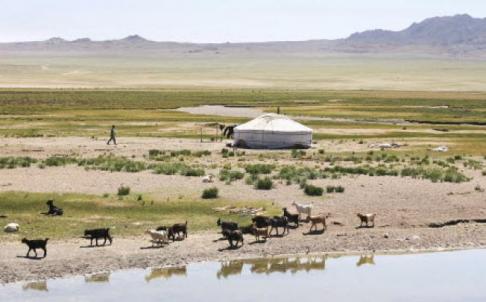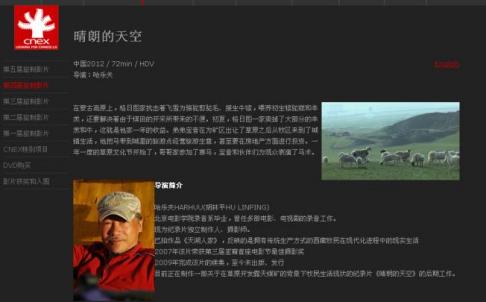| South China Morning Post |
| April 11, 2013 |
| Mandy Ng |
At the the 37th Hong Kong International Film Festival, a Mongolian filmmaker powerfully exposes the destructive impact mining is having on China's pastureland.
 |
|
| In Mongolia's Gurvansaikhan
National Park, the Camel Lodge (left) offers guests luxuries and spa
treatments in yurts, which traditionally house Mongolia's nomadic
herders (above) in the Gobi Desert. Photo: SCMP pictures
|
|
 |
|
| A screenshot of the fim's official website shows the director Hu Linping. Photo: SCMP pictures |
I applaud the Chinese documentary A Clear Sky - which recently premiered at the 37th Hong Kong International Film Festival.
I admire the film for its honesty in examining the toll China's rapid economic growth has been taking on the country's environment and people's traditional way of life.
In A Clear Sky, director, Hu Linping, also known as Harhuu, recounts the lives of the Gerituan family, who have been farming cattle for generations on the vast Xilin Gol grasslands of Inner Mongolia.
We learn about their daily hardships. The film opens with a scene where the family rescue a camel during a snowstorm. They help a cow deliver a calf, which later dies.
Livestock are crucial to the family, who make a living breeding and selling animals. But their old life is under threat. It changes, forever, when the father and son notice a seam in the ground. This usually means a mine has been discovered nearby.
Their fears are confirmed when the television news announces that coal mining has started in the area.
Soon, a long railway line extends deep into the pastureland. Many outsiders arrive.
The farmers try to carry on with their lives. A wedding ceremony is held. People celebrate through their long-established customs.
But the tranquil scene quickly fades as the film shows two brothers hunting for an apartment in a nearby city. The new commercial culture is now impacting on people - forcing many to look for work in the cities
The film culminates with an official saying the area's new infrastructure has greatly boosted the economy. But A Clear Sky challenges this, showing a giant coal mine expanding onto pastures, leaving little land for livestock. Heavy, dark smoke emits from nearby chimneys, polluting a once "clear sky".
The director told his audience at Q&A session that industrialisation has transformed the landscape of Inner Mongolia. He said the local culture, language and traditional faming were now at risk.
Hu spent three years making the documentary. A Clear Sky is a timely and important film because many are now debating the social and environmental cost of China's economic growth. Huís documentary provides a vivid glimpse of what industrialisation really means in many parts of China.





 Beyond
Great Walls: Environment, Identity, and Development on the Chinese
Grasslands of Inner Mongolia
Beyond
Great Walls: Environment, Identity, and Development on the Chinese
Grasslands of Inner Mongolia China's
Pastoral Region: Sheep and Wool, Minority Nationalities, Rangeland
Degradation and Sustainable Development
China's
Pastoral Region: Sheep and Wool, Minority Nationalities, Rangeland
Degradation and Sustainable Development The
Ordos Plateau of China: An Endangered Environment (Unu Studies on
Critical Environmental Regions)
The
Ordos Plateau of China: An Endangered Environment (Unu Studies on
Critical Environmental Regions)